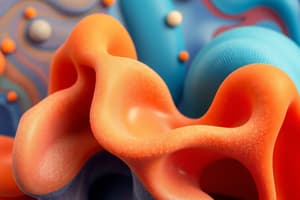Podcast
Questions and Answers
What is one of the primary roles of packaging in pharmaceuticals?
What is one of the primary roles of packaging in pharmaceuticals?
- To enhance the flavor of the product
- To make the product visually appealing
- To protect the product from environmental conditions (correct)
- To create bulk for transportation
Which characteristic of packaging materials is essential to ensure consumer safety?
Which characteristic of packaging materials is essential to ensure consumer safety?
- Must contain preservatives
- Must be FDA approved (correct)
- Must be brightly colored
- Must be heavy-duty
What is the purpose of including tamper-evident features in packaging?
What is the purpose of including tamper-evident features in packaging?
- To provide additional marketing information
- To indicate if the package has been tampered with (correct)
- To make the package look attractive
- To ensure easy opening of the package
Which type of packaging directly holds the pharmaceutical product?
Which type of packaging directly holds the pharmaceutical product?
How does packaging contribute to marketing efforts?
How does packaging contribute to marketing efforts?
What is a primary concern regarding the interaction of packaging materials with the product?
What is a primary concern regarding the interaction of packaging materials with the product?
What is meant by barrier protection in pharmaceutical packaging?
What is meant by barrier protection in pharmaceutical packaging?
Why is permeability consideration important in packaging design?
Why is permeability consideration important in packaging design?
What is encompassed in primary packaging?
What is encompassed in primary packaging?
Which type of packaging is specifically used for bulk handling and transport?
Which type of packaging is specifically used for bulk handling and transport?
Which material is NOT commonly classified as a packaging material?
Which material is NOT commonly classified as a packaging material?
What is a significant disadvantage of glass as a packaging material?
What is a significant disadvantage of glass as a packaging material?
What is the primary use of Type I glass in packaging?
What is the primary use of Type I glass in packaging?
Which type of glass is the most non-reactive?
Which type of glass is the most non-reactive?
Which packing type is suitable for grouping primary packages together?
Which packing type is suitable for grouping primary packages together?
Which type of glass is strongest and most versatile for general use?
Which type of glass is strongest and most versatile for general use?
What is one of the main advantages of using cartons in pharmaceutical packaging?
What is one of the main advantages of using cartons in pharmaceutical packaging?
Which material is NOT included in the category of fibrous materials used for pharmaceutical packaging?
Which material is NOT included in the category of fibrous materials used for pharmaceutical packaging?
What is the primary function of aluminum foil in packaging?
What is the primary function of aluminum foil in packaging?
What is 'metallization' in packaging materials?
What is 'metallization' in packaging materials?
Which of the following applications is least likely to utilize films and foils?
Which of the following applications is least likely to utilize films and foils?
What characteristic of regenerated cellulose film is highlighted in the content?
What characteristic of regenerated cellulose film is highlighted in the content?
In what technology does 'Co-Extrusion' play a significant role?
In what technology does 'Co-Extrusion' play a significant role?
Which of the following is NOT a benefit of packaging films and laminates?
Which of the following is NOT a benefit of packaging films and laminates?
Which type of glass is suitable for non-aqueous injectables?
Which type of glass is suitable for non-aqueous injectables?
Which type of glass container should be used for aqueous injectables of pH less than 7?
Which type of glass container should be used for aqueous injectables of pH less than 7?
What is the primary characteristic that distinguishes Type II and Type III glass?
What is the primary characteristic that distinguishes Type II and Type III glass?
Which type of glass is suitable for packaging blood and related products?
Which type of glass is suitable for packaging blood and related products?
For which type of products is Type IV glass recommended?
For which type of products is Type IV glass recommended?
What is the main advantage of using Alu-alu foil for pharmaceutical packaging?
What is the main advantage of using Alu-alu foil for pharmaceutical packaging?
Which characteristic of Alu-alu foil enhances its effectiveness in drug storage?
Which characteristic of Alu-alu foil enhances its effectiveness in drug storage?
Which metal containers are used for medicinal products?
Which metal containers are used for medicinal products?
Which packaging type requires Type I glass for aerosols?
Which packaging type requires Type I glass for aerosols?
What role do closures play in pharmaceutical packaging?
What role do closures play in pharmaceutical packaging?
What is the minimum quality of glass that can be used for tablets and capsules?
What is the minimum quality of glass that can be used for tablets and capsules?
Which material is NOT commonly used for closures in pharmaceutical packaging?
Which material is NOT commonly used for closures in pharmaceutical packaging?
Which type of glass is not suitable for parenteral products?
Which type of glass is not suitable for parenteral products?
What type of products is Alu-alu foil particularly suitable for packing?
What type of products is Alu-alu foil particularly suitable for packing?
What symbols are commonly used on pharmaceutical packaging?
What symbols are commonly used on pharmaceutical packaging?
Certain types of external semisolids require which type of glass for packaging?
Certain types of external semisolids require which type of glass for packaging?
What is one of the main functions of using closures in containers?
What is one of the main functions of using closures in containers?
Which of the following statements about Alu-alu foil is false?
Which of the following statements about Alu-alu foil is false?
Flashcards are hidden until you start studying
Study Notes
Packaging Definition and Characteristics
- Packaging is the science, art, and technology of enclosing or protecting products for distribution, storage, sale, and use.
- Packaging materials must meet tamper-resistance requirements, be FDA approved, non-toxic, and not impart odor/taste to the product.
- Packaging materials must be non-reactive with the product and protect it from environmental conditions.
Uses of Packaging
- Physical protection: Protection from mechanical shock, vibration, electrostatic discharge, compression, temperature.
- Information transmission: Labels communicate how to use, transport, recycle, or dispose of the product or package.
- Marketing: Packaging and labels used by marketers to encourage purchases.
- Convenience: Provides features that add convenience in distribution, handling, stacking, display, sale, opening, re-closing, use, dispensing, reuse, recycling, and ease of disposal.
- Barrier protection: Packaging from oxygen, water vapor, dust, etc., is often required. Includes desiccants or oxygen absorbers.
- Security: Packaging can reduce shipment security risks.
- Tamper-resistance to deter tampering and tamper-evident features to indicate tampering.
- Reduced pilferage risk.
Types of Packaging
- Primary packaging: The material that first envelops the product, in direct contact with the contents. Examples: Ampoules, Vials, Containers, Dosing dropper, Closures, Syringe, Strip package, Blister packaging.
- Secondary packaging: Used to group primary packages together. Example: Paper and boards, Cartons, Corrugated fibers, Box manufacture.
- Tertiary packaging: Used for bulk handling, warehouse storage, and transport shipping. The most common form is a palletized unit load that packs tightly into containers.
Types of Packaging Materials
- Glass:
- Advantages: Hygienic, suitable for sterilization, relatively non-reactive, accepts various closures, used on high-speed packaging lines, transparent, good protection power, easily labeled.
- Disadvantages: Heavy, fragile, can release alkali to aqueous preparations.
Types of Glass
- Type I (Neutral or Borosilicate Glass): Least reactive, higher ingredients and processing cost, used for sensitive pharmaceutical products (parenterals or blood products), mostly ampoules and vials.
- Type II (Treated Soda lime glass): Higher chemical resistance than Type III, cheaper than Type I, acceptable for most products except blood products and aqueous pharmaceuticals with a pH less than 7.
- Type III (Soda lime glass): Similar composition to Type II, distinguished by hydraulic resistance. Average or slightly better resistance, suitable for non-aqueous parenterals and non-parenteral products. Containers normally dry sterilized.
- Type IV (General purpose soda lime glass): Lowest hydraulic resistance, suitable for solid products, some liquids and semi-solids, not for parenteral.
Glass Packaging Recommendations
- Ampoules: Aqueous injectables of any pH - Type I; Aqueous injectables of pH less than 7 - Type II; Non-aqueous injectables - Type III.
- Vials: Aqueous injectables of any pH - Type I; Aqueous injectables of pH less than 7 - Type II; Non-aqueous injectables - Type III; Dry powders for parenteral use (need to be reconstituted before use) - Type IV.
- Bottles and Jars: Tablets, capsules, oral solids & other solids for reconstitution - Type IV; Oral liquids (solutions, suspensions, emulsions) - Type IV; Nasal & ear drops - Type IV; Certain types of external semisolids - Type IV.
- Dropper: Blood & related products - Type I; Auxiliary packaging device with certain kind of products - Type IV.
- Aerosol container: Aerosol product (solution, suspension, emulsion or semisolid type) - Type I.
Metals
- Metal containers are used solely for non-parenteral administration.
Plastics
- Plastic bottles made from PP, HDPE, and PS; plastic pouches of HDPE; bottles of PET and spray-PP.
Fibrous Materials
- Paper, labels, cartons, bags, outers, trays for shrink wraps, layer boards on pallets.
- Cartons increase display area, provide better stacking, assemble leaflets, and provide physical protection.
- Corrugated fiberboard outers are used for bulk shipments.
- Regenerated cellulose film (Cellophane and Rayophane) is used for individual cartons or to assemble several cartons.
Films, Foils, and Laminates
- Regenerated cellulose film, laminations of films, cellulose coatings, foil, and paper.
- Aluminum foil offers the best barrier properties.
- Metallization improves barrier properties of a material with a vacuum process.
- Co-extrusion produces cheaper laminations by combining multiple plastic plies.
- Uses include strip packs, blister packs, sachets, diaphragm seals for bottles, liners for boxes, and bag-in-box systems.
- Foil blisters provide hermetic packs that exclude gas exchange.
- Alu-alu foil is a good substitute for PVC film, has good blocking properties, extends storage period, is used for moisture-sensitive drugs, is used by cold-molding packaging machines.
Closures
- Closures are devices used to open and close containers.
- They prevent loss of material, contamination, and deterioration from the environment.
- Materials used for closures include cork, glass, plastic, metal, and rubber.
Symbols Used on Packages and Labels
- Many are nationally and internationally standardized for product certifications, trademarks, proof of purchase, etc.
- Examples include:
- Fragile
- This way up
- Keep away from sunlight
- Keep away from water.
Studying That Suits You
Use AI to generate personalized quizzes and flashcards to suit your learning preferences.




